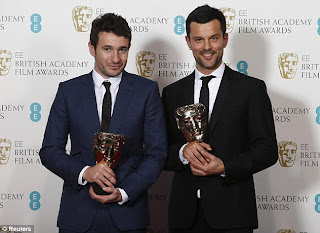BAFTA awards for Bart Layton, Dimitri Doganis, Documentary 'The Imposter'
Director, Bart Layton and producer Dimitri Doganis, won the BAFTA award 2013 last night in London, for an outstanding Debut by a British writer, director or producer.
The Imposter” is a documentary film of a difference, rather than a factual documentary, a a true story dramatically told, still maintaining the documentary elements. Made by a talented and experienced team who bypass the boundaries in terms of film making or controversial issues to bring a fascinating topic to screen.
British director Bart Layton tells the true story of soemone who steals an identity to create a life, via a unique cinematic language which combines stylistic (including Film Noir) and documentary elements.
The film centers on the true facts of the disappearance of a 13 year old boy in 1994, Nicolas Barclay from San Antonio, Texas, he was ‘discovered' and found alive three and a half years later in southern Spain, with a tale of kidnap and torture. His family is elated, overcome with emotion and start the process for him to return to his home in the Unites States. However, this is where the true story really starts to
take its course, as all is not quite as it seems......
Layton, whose trademark is a film making style which favors visual innovation and challenging the conventional norm, is well-known in both the UK and the U.S. for his acclaimed documentaries. His accomplishments: shortlisted for a BAFTA award, finalist for The Royal Television Society, and also at the Grierson Awards. He uses his experience and connections to gain access to ‘volatile' environments such as
maximum security prisons in Latin America.
The film is executive produced by John Battsek, who produced the Academy Award-winning “One Day in September.” Also producer Dimitri Doganis, best known for his work on “Locked up Abroad,” which airs on National Geographic, and Simon Chinn, who produced “Man on Wire,” which has won over 30 international awards, including the Academy Award for Best Documentary Feature.
“The Imposter” was shot by Erik Alexander Wilson, the director of photography whose credits include “Tyrannosaur,” for which he received the World Cinema Directing Award at Sundance 2010. Andrew Hulme, the film's editor, is known for Anton Corbijn’s “Control & the American,” “Gangster No 1,” and documentaries such as “A History of a Blue Note.”
Layton’s inspirations for the film were sparked by an article in a Spanish magazine about Frédéric Bourdin, aka Le Chaméléon, who assumed hundreds of false identities while traveling throughout Europe. He was placed in care homes as a traumatized child, and managed to fool authorities at the highest level--including
the FBI. An Internet search led to more articles and facts. Layton started to correspond with Bourdin via his Youtube account and persuaded him to meet the film team in London.
“You could wait a lifetime to happen upon a story such as this,” Layton said. “A work of fiction would be far fetched…[How first hearing about this case] sparking an urgent need to find out more... about a man capable of perpetrating such a crime ...and a family capable of becoming victims to it.”
Co-producer Poppy Dixon had to do some detective work to find the family; they were initially reluctant to take part due to previous pursuits by other media and filmmakers. However, with this project, it seemed that they would have the opportunity to set the record straight in their own words as there had also been a lot
of negative press circulating about the family.
The Barclay that returns to the family possesses many of the same distinguishing marks that made him 'recognizable' as their child, but his strange accent, and totally opposite looks to that of the missing child start to spark suspicions. Only the family seems to have not paid attention to these differences and welcome this boy with open arms back into the family unit. Bourdin had a thick accent, olive skin, dark hair and dark brown eyes,whereas Nicolas Barclay was blond, blue-eyed with a distinct American accent.
This shapes a series of events which unfold in the film’s unexpected twists and turns. The case is then picked up by a private investigator whose instincts led him to recall how the assassination of Martin Luther King Jr. by James Earl Ray was solved on his capture at Heathrow Airport, London, when Ray was identified by the shape of his ears, which was the flaw and the nail which caught out 'Le Chameleon' aka Frederic Bourdin.
Bourdin felt a need to create a 'life' for himself, as he felt unloved, and lacked a normal loving childhood and was successful in his endeavors in this respect through his pathological lies, master storytelling, persuasions and convincing phone calls to get what he wanted to achieve. Bourdin was elated that his 'sister' was coming all the way from Texas to retrieve him, that was considered in his eyes as an act of love,and was willing to go to great to be the child that they were coming to retrieve.
Says Bourdin in the film, “They were a family without a kid; I was a kid without a family.”
At times, when meeting some of the other characters in the story and their amazing and differing accounts of the facts, Layton wondered whether this bordered on fiction rather than reality.
“Every person we talked to seemed to have their very own version of the truth and all of them as believable yet implausible as each other,” he said.
The story perplexes almost everyone who comes in contact with it, including an FBI agent who realizes that the case she is investigating is a work of fiction. The family fragmented, bereaved and still disturbed by their close encounter with the man who had claimed to be their long lost loved one, and had lived as their child for nearly five months. But other details emerged, the missing boy, Nicolas Barclay, had been troublesome and had run away before. When he turned up on the other side of the world it seemed incredible but plausible. Bourdin even managed to convince a court that he was this boy, by identifying all the family photos.
The challenging question for Layton as a filmmaker was how to relate the story where the truth was not definitive but elusive. To make an effective film, he decided to take the audience on a roller coaster ride which attempts to tie together the disparate narratives, versions of truth, and raw emotions of everyone involved.
Layton often felt he was part of a detective story, with each interview yielding a new clue, but coming up with a completely different conclusion by the end of each session.
“The challenge as a director was how to make a documentary, which in many ways is about the elusiveness of truth, truthfully,” he said.
One of the hardest parts in trying to portray the story was trying to make sense of the subjective and conflicting events that were described by the interviewees, and how to compress all that information into a 90 minute film.
Seeking to follow each character’s journey in chronological order would help the story to unfold, while trying to find a medium in which to portray the events in a visual language that would be unique to any other documentary already seen.
Using a different meaning of portraying the story in this genre, Layton sought not to reconstruct events but vividly create sequences that would incorporate dreams, visions, reality, atmosphere and circumstances.
The re-enactments were shot on location in and around Madrid for the Spanish section of the film and in and around Phoenix, Arizona, for the Texan portion of the film, using the Arri Alexa, which was the digital camera which could most closely achieve the look of 35mm film--utilizing the idea of playing with notions of memory and subjectivity. To preserve the narrative, the emotion was driven by the testimony rather than the dramatic elements.
“The Imposter” is more than just a retelling of a case of mistaken identity; it’s an emotional journey, and afterwards, anybody seeing it will have many thoughts, questions and debates about what is true, and what is made to be believed in the course of the story that unfolds in this film. The expected becomes the unexpected
and flits between the two, throughout the film, when the viewer thinks they are certain of a fact, something else blows the whole thought at that time on its head.
“My hope is that the film takes the viewer on not just one journey but on a series of concurrent journeys with a number of compelling characters each with their own version of the truth and their own complex reasons for constructing those truths,” Layton said. “I hope this allows the audience to form and reform their own opinions as to what actually happened--in much the same way has we have done in the process of making the film.”
Lets also spare some thoughts as remember that Nicholas Barclay was 13 the day he disappeared (June 13, 1994). He would have been 16 and eight months when he was reported found in Spain (October 7, 1997), and to this date remains missing...
IMDB link:
http://www.imdb.com/title/tt1966604/



Comments
Post a Comment